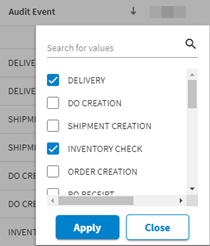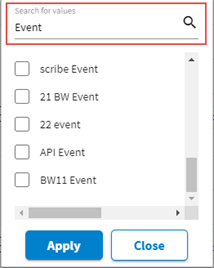Searching Transactions
The search features in AuditSafe are powerful and easy to use. You can filter your searches by constricting them to columns, to values with columns (categories) or search using date/time ranges. These are only a few of the options available.
Throughout this topic are suggestions and recommendations on how to target your searches and limit the number of results.
When you search transactions, the search finds matching records even if a category (or column) is not displayed. Hide or show categories by selecting them from the Settings dialog. For more information, see Settings in the Transactions Tab.
Pagination Limits for Searches
Pagination for search results is limited to 500 pages. If your search returns more results than the limit, you will receive a message requesting that you refine the search criteria.
Some suggestions to improve your search results are to add criteria such as tighter Date limitations, or limiting transaction searches to specific columns. See Using Search below for guidelines.
Managing Search Criteria
You can save, view, edit and delete multiple search criteria.
- After you apply the search criteria, click Save Search Criteria and select Save As. Enter the name of the search criteria and click Save to save the search criteria.
- To view the saved search criteria, click Search Criteria drop-down icon.
You can view all the saved search criteria in Load Search Criteria dialog box. - In the Load Search Criteria dialog box, click on the saved search criteria you want to load. Update the search criteria by modifying columns and click Save.
- Delete the search criteria using the Delete icon in the Load Search Criteria dialog box.
You cannot delete the search criteria that is already loaded on the Transactions page.
Clearing a Search
Clear a search by clicking X (delete) on a search box or by selecting the Clear All Searches option on the right.

For complex searches using multiple terms across multiple columns, clicking on X clears only that section of the search. Other search parameters remain active and the search is revised using the remaining options.
Using Search
When searching, you can use one of the following options or combine them to narrow the results:
- Sorting Transactions
- Search using the Transactions Field
- Search using Column Search
Sorting Transactions
The simplest option. Sort any column using the down/up arrow to sort the results in ascending or descending order. This option is most helpful after you create a complex search, since it allows you to sort on a smaller set of results.
Using Search Transactions
The Search Transactions field which appears at the top of the transaction list allows you to search using one of the following options.
- Keyword search. Select this option to enter any word or part of a word.
- Search on Columns. Columns are listed alphabetically. Select a column from the list.
You can also search for Payload column. The operators used for Payload column are different from the other columns. It has ‘contains’ and ‘not contains’ operators. Note: Results are not filtered when you use special characters for Payload search.
For example, for test_Payload: !@#$%^&*(02-08)/[00] {9-9}, you can search with the following term:
test_Payload
(02-08)
[00]{9-9}
!@#$%^&*(02-08)/[00]
{9-9}
Note that you cannot use symbols like !@#$%^
- User-defined terms. These are terms created by you and are listed under a divider. They also appear in alphabetical order.
On the Transactions page, the search drop-down list displays limited extra properties based on the transaction type.
These search-types can be combined to create a complex search. Once you have entered all of the search criteria. Click Find to view the results.
- Click the Select dropdown to choose a category.
- Click in the
Search Transactionsfield, select a search option (seen above), and enter a word. - As you begin to enter a word, the system displays the available options.
- Select an option and press
ENTERto add it to your query. Continue adding options to narrow your returns. - Once you have created your query, click Find to list the results.
- Click the X (Delete) icon to remove a search term.
Search Transactions contains the following options:
| Search Option | Description |
|---|---|
| = | Equals: Finds an exact match for a term. Entering the first few letters will list matching options. Select one and press ENTER. If an exact match is not available, no items are listed. |
| != | Not Equal to: Use this option to exclude terms from your search. |
| ~ | Like: Enter a few letters to list items containing a matching string. |
Creating Searches from Search Transactions
-
Searching for values within the same category is an OR search.
For example: Search Audit Event for Delivery or DO Creation to find all transactions that contain those values.
-
Searching for values between 2 or more categories is an AND search. You can combine the two search-types to narrow your results.
For example: Search Status for Pending OR Completed, AND search Audit Event for Delivery.
The system automatically segments your query into OR and AND searches as seen in the following example:

Using Column Search
You can combine the Search Transactions searches with column-based search, or use it as a separate and quick way to search transactions using the values available in that column.
- To search a column, click on the column name to open the column search dialog.
-
The dialog lists available values within that column.

-
Scroll to view the list or search for values using the search box. The search narrows the available choices as you enter a term. Note that the search is NOT case-sensitive.

- Check the box next to a term to select it.
- Click Apply to confirm your choices.
-
The search is modified to include only the values you selected for the column.

- Open the column search at any time to remove existing, or select additional terms from any column. The search bar displays the changes and the search results are immediately modified.
